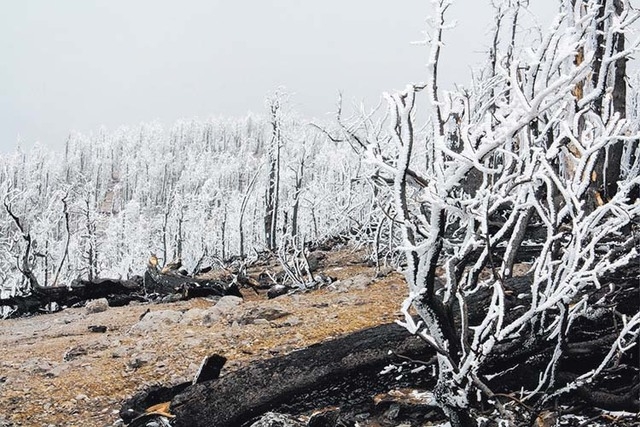3 years after fire, 2 more Mount Charleston trails set for repairs
If you see men on horseback carrying saws up Mount Charleston this summer, don’t be alarmed. They’re just there to fix the trails.
Almost three years after the Carpenter 1 fire burned through the Spring Mountains, the U.S. Forest Service is about to start work on two trails closed by the blaze.
Repairs to the South Loop and Griffith Summit trails are slated to get underway in the coming months and wrap up in the fall.
Much of the work will take place within a federal wilderness area, so workers won’t be allowed to use mechanized equipment such as trucks, chainsaws or heavy construction machinery to access the trails or remove debris.
There was talk of using explosives to clear away some of the largest fallen trees, but the crews will use hand saws, picks and shovels instead, said Naaman Horn, spokesman for Spring Mountains National Recreation Area.
“Explosives are allowed in wilderness areas, but we’re planning to do the work with the minimum tool,” he said.
It won’t be easy. Horn said there are hundreds of downed trees blocking trails in and around the 28,000-acre area burned by Carpenter 1. The largest is a ponderosa about 12 feet in diameter.

Sections of trail also were damaged by flooding and erosion made worse by the loss of vegetation during the fire.
Horn said debris cleared from the trails will be left on the mountain to maintain the wilderness character of the area.
The work will be done by two six-person crews from the Great Basin Institute and the Nevada Conservation Corps under the supervision of the Forest Service. Horn said they will use horses and mules to haul equipment, supplies and themselves to the rugged, high-elevation work area.
The 8-mile-long South Loop Trail leads out of Kyle Canyon to the 11,916-foot summit of Mount Charleston, which is accessible only via the longer North Loop Trail. The Griffith Summit Trail is a half-mile spur leading off the South Loop Trail to the top of Griffith Peak, 11,059 feet high.
Before launching the work, the Forest Service had to submit details to U.S. Fish & Wildlife Service, the agency in charge of protecting the little-seen and critically endangered Mount Charleston blue butterfly.
The South Loop Trail passes through prime habitat for the butterfly, and the restoration could disturb as much as 10 acres used by the insect.
After a lengthy consultation, the Fish & Wildlife Service signed off on the plans in January.
Once repairs are complete, there will be just one route — the 4-mile-long Griffith Peak Trail — still closed as a result of the lightning-sparked fire that burned for more than a month in summer 2013.
There is no projected opening date for the trail, which leads up the eastern slop of Griffith Peak and sustained some of the worst damage from the fire and its aftermath.
Horn said all but a fraction of the trail was affected, with large sections washed away by floods made worse by the loss of vegetation. The charred husks of fallen trees litter what’s left of the trail.
Even if it were open, there’s no way for hikers to reach the trailhead. In 2014, federal officials issued a five-year closure order for thousands of acres surrounding the trail, including the dirt road that leads to it from state Route 157, the highway into Kyle Canyon.
The closure takes in the area hardest hit by Carpenter 1 and is meant to give the landscape time to recover.
Three other hiking trails closed by the fire — Cathedral Rock, Echo and Little Falls — reopened last May.
More information about trail conditions is available by calling the Spring Mountains Visitor Gateway, 702-872-5486 or going online to www.gomtcharleston.com.
Contact Henry Brean at hbrean@reviewjournal.com or 702-383-0350. Follow @RefriedBrean on Twitter.


















